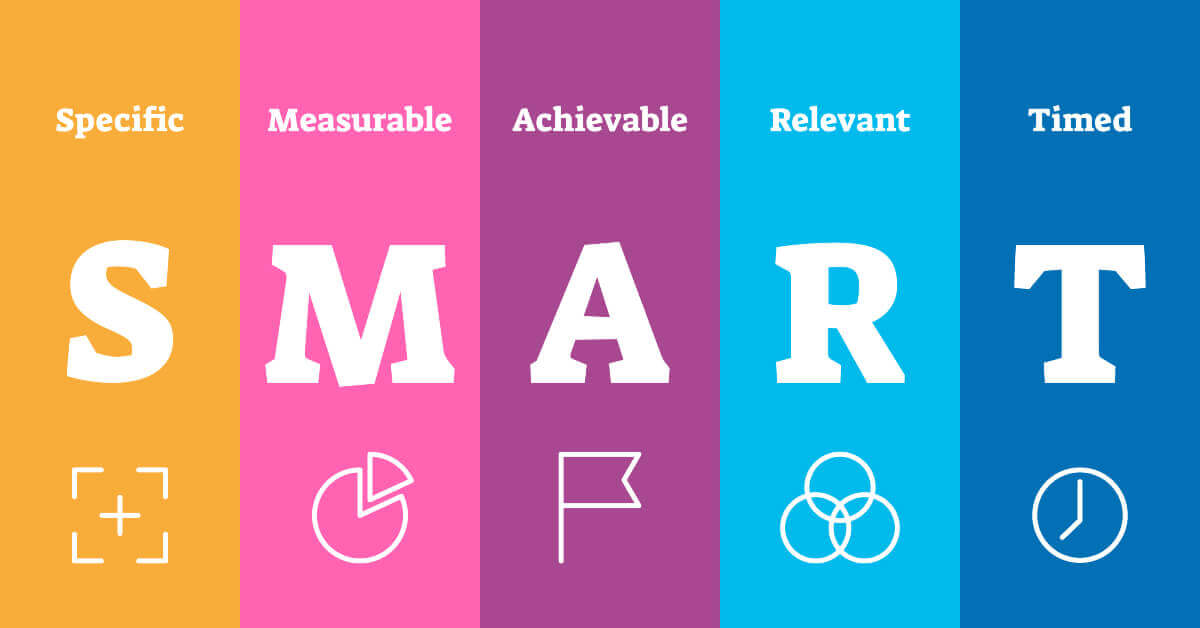Realistically, when you wake up on January 1st, 2022, it will be a day much like December 31st, 2021. But, for many of us, the end of the year signals a time for reflection on the last 365 days. It’s when we identify what we’ve accomplished and the areas we want to improve upon. The approaching new year gives us a blank slate feeling and with that comes the opportunity to make changes and set New Year’s resolutions. A way to ensure success with your New Year’s resolutions is to create SMART goals.
New Year’s Resolutions Can Be Too Broad

I used to love setting New Year’s resolutions. There felt like no better time to start anew than the first day of the new year. There were always areas I wanted to improve upon. Even though I understand that change can happen on any day, this temporal landmark really helped motivate my optimistic and aspirational behavior.
But what happened is I would set big lofty goals. And every year without fail, I would find myself abandoning these goals about a week in.
Some of my typical resolutions:
- Lose weight
- Stop eating sugar
- Exercise
- Be better with money
At the end of every year, I would look back on the goals I set and feel unaccomplished. Eventually, I began to skip setting goals because I felt like I wasn’t going to achieve them anyway.
A Different Way of Goal Setting
My approach to New Year’s resolutions changed when I was introduced to SMART goals at my job as a pharmacist. SMART goals are specific, measurable, achievable, relevant and time bound.
We use this method of goal setting when working with our patients. For example, let’s say that we’re working to encourage a patient to incorporate fitness more regularly into their life. Advising them to “exercise” is too general. They would likely be thinking: What type of exercise? How much exercise? Everyday? When should I achieve this goal?
They’re unlikely to get great results because the goal is too broad and open-ended. Likewise, advising a patient that isn’t active and doesn’t like exercising to “start doing an hour of HITT daily” isn’t realistic either.
Smart Goals Help Us Create Realistic Targets
When setting a SMART goal, both the healthcare provider and the patient must reflect to create a goal that is clear, feasible and easy to follow up on. It’s also important in our field that the goal matters to both to health care provider and the patient. Here’s an example of a SMART goal:
“By February 2022, I will commit to a HITT class for 30 minutes, three times a week, because lowering my cardiovascular risk is important to me.”
Setting Your Own SMART Goals

When I worked with my patients to set these types of goals, I realized that coming up with a SMART goal forces us to create realistic and actionable targets for the desired behavior change. It also creates a time frame for you to circle back and check in on your progress. This method of goal setting ties in perfectly with the intent of New Year’s resolutions.
Set aside some time to rework your New Year’s resolutions into SMART goals. Reflect and consider the different components below. Consider writing down your goal because it will be easy to go back and adjust your goal as needed.
Here’s an example of reworking my “be better with money” New Year’s resolution into an actionable SMART goal.
Related Articles
Specific:
Questions to ask:
- What exactly am I trying to accomplish?
- What do I need to do in order to achieve it?
I want to be better with money. One aspect that I’ve really been struggling with is buying Starbucks too frequently. This is a habit that’s no longer providing me with any joy and I would like to cut my purchases in half.
Measurable:
The next step is to add in a quantifiable aspect to your goal. This part of your goal is important because it allows you to keep track of your progress. It also makes sure that you goal is realistic and lets you know when you’ve met your goal.
This can be anything: you create a log, record the number of steps you take, or track your spending per month.
I want to reduce the amount of spending at Starbucks from $100 a month to $50 a month. The amount of money I spend per month will be how I measure my progress.
Attainable:
Little goals make the big goals happen. It’s great to be ambitious, but a big lofty goal in itself may seem daunting or discouraging. Consider each SMART goal you make as working towards your overarching goal.
My ideal goal would be to drink all my regular morning coffee from at home. However, purchasing morning coffee is a deeply entrenched habit and this goal is not quite attainable yet. But cutting my purchases in half at Starbucks is an attainable goal for me.
Relevant:
Check in with yourself: Why is this your resolution? If this goal isn’t important or relevant to you, you’re unlikely to be motivated to achieve it.
I have a lot of financial goals I’m currently working to achieve. I really don’t feel like my regular Starbucks habit is adding to my life and I think that money could definitely be better spent elsewhere.
Time-bound:
As SMART goals focus on attainable specific aspects of an overarching goal, you don’t want the timeline to be indefinite. You need to choose a time to check in and evaluate to see where you are.
I want to have achieved my 50% reduction in spending at Starbucks by March 2022.
The Bottom Line
The SMART goal framework has made its way into our professional lives but it also has a great place in helping us achieve our personal aspirations. By using this format, you can create a clear pathway to achieve the change that you are looking for. Consider using SMART goals this year when setting your New Year’s resolutions!







